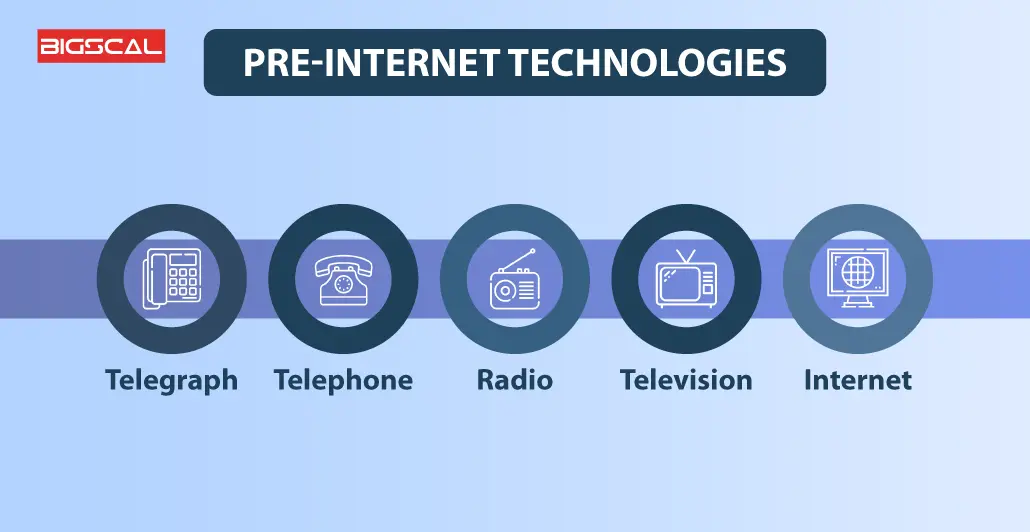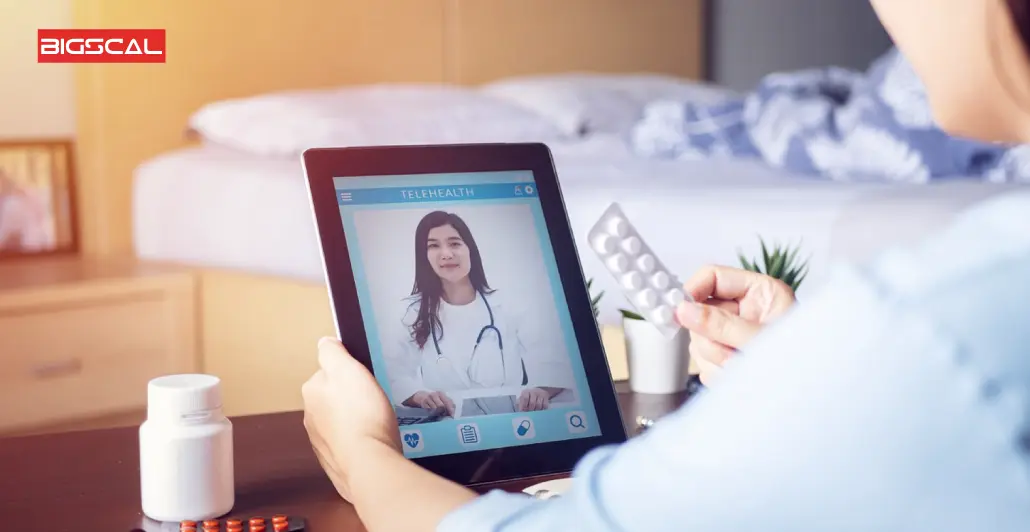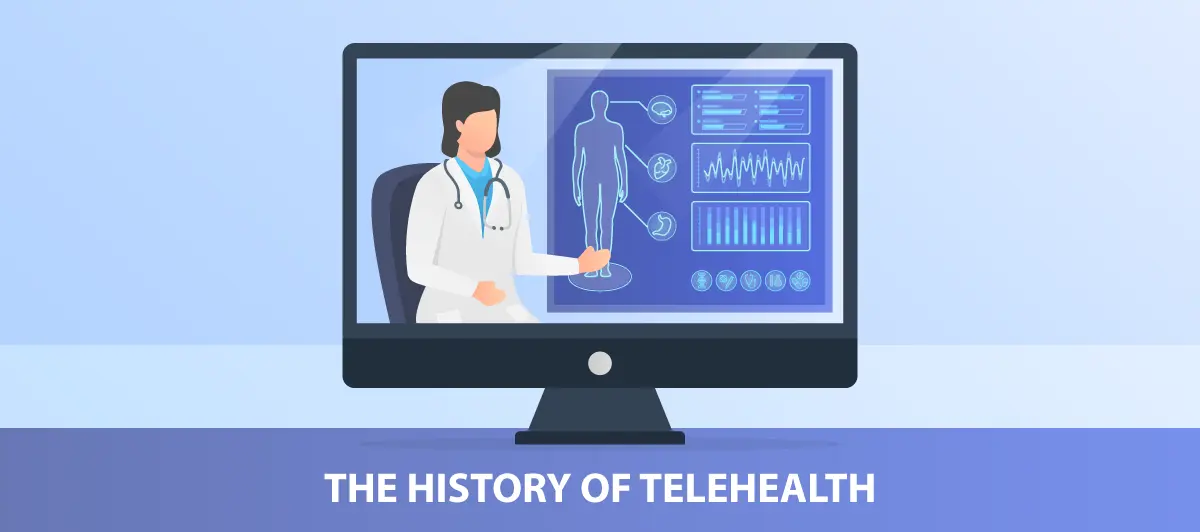When was Telehealth Invented?
Quick Summary: Seeking answers to when Telehealth was invented? It is a revolutionary healthcare practice that originated in the mid-20th century. However, it truly evolved in the 1960s when telemedicine experiments took place. Telehealth has advanced significantly, offering remote healthcare services via technology, making medical care accessible and convenient. Know more about a telemedicine background!
Introduction
Telehealth has mended how healthcare professionals treat and have an eye on their patients. Although technological advancements had an impact on the adoption of Telehealth, the COVID-19 pandemic was also a contributor. Know that it was not a new term.
The health system has been using remote monitoring to treat patients for a long time. Hence, this might provoke a question: When was Telehealth Invented? Since the 1940s.
The virtual care you see today uses both hardware and software for health-related education, examination, and healthcare delivery. After the pandemic hit, medical professionals have started relying more on telehealth technology to treat them virtually.
Per a survey from the Centers for Disease Control and Prevention, telehealth visits have increased by 154% by the end of March 2020 compared to 2019. As in-person visits are less preferred these days, virtual medicine is becoming an integral part. But when did Telemedicine start or when did telehealth start? Keep reading to explore the evolution of telehealth.
What is Telehealth?

Before knowing when was telehealth invented and who did it, it’s crucial to understand its meaning. Telehealth, often used interchangeably with Telemedicine, refers to remote non clinical services, specifically to providing remote healthcare services. It lets a provider care for a patient without needing an in-person visit.
Professionals conduct Telehealth visits through internet access and communication technologies such as tablets, phones, or computers. One tends to have several options to obtain remote clinical services, such as:
- Consult a physician through a phone call or video chat.
- Connect through exchanging messages with the healthcare provider using secure messaging, email, and secure file exchange.
- Employ the facility of remote patient monitoring to ensure that the provider can check your vital data. You can use devices that share electronic information with your doctor about progress.
A person can get medical supplies and even seek different kinds of specialized medical care with Telehealth. Virtual health is crucial for people living in rural areas as it can help change medications for chronic illnesses.
Remember that often, your primary care physician will decide whether Telemedicine will work for your health needs. Here is a list of care that you can gain through Telehealth
- Gaining access to lab tests or X-ray
- Seeking telemedicine consultations for mental health, like online therapy
- Dealing with recurring conditions and chronic diseases
- Physical examination for skin conditions
- Prescription management
- Remote communication for follow-up visits after surgery
- Seeking medical care for issues like stomach ache and cold
- Facilitate remote patient monitoring for attention deficit disorder and attention deficit hyperactivity disorder
- Remote monitoring services and electronic health records to keep track of health goals and manage chronic conditions such as high blood pressure and high cholesterol
When did Telehealth begin?

Are you caught in a tough spot and thinking about when was telehealth invented? Or what is virtual healthcare? Well, this concept of digital health has evolved drastically from house calls to urgent care centers. On-demand health care services have taken over the entire community.
Patient engagement is necessary these days, and they need 24/7 access to the doctors. Hence, physicians use it to monetize remote assistance. Technological advancements like Skype and Facetime have existed for a long time, maybe from the first half of the 20th century.
Thomas Bird coined the term Telehealth or Telemedicine was coined in the 1970s. The translation of this word goes like healing at a distance.
Later, technologies like the telegraph and telephone came into existence, adding to Telehealth services usage. Professionals and nurse practitioners these days offer telehealth services through various modes of communication. In the past, these communication technologies were human messengers that transmit data over distances.
The introduction of telegraphs and telephones further added to its usage. The invention of these technologies allowed people to transmit data over distances. But telegraphs need expertise to operate.
Hence, the civil war military was fast enough to recognize and seek benefits from telegraphs and telephones for electronic health records administration. It further led to the widespread adoption of digital health.
History of Telehealth: Overview
Early Days: when was telemedicine invented?
When was the concept of Telehealth brought to the market? Most of us think that the history of Telehealth starts from the COVID era. Virtual health system usage skyrocketed overnight during the pandemic, but it is an age-old term.
When you have a glance at the history of Telehealth, you will see there are a lot of reasons behind the innovation of Telehealth in medical facilities. These days, the majority of hospitals and clinics in the United States offer care on a virtual basis.
Although people use emerging technologies like video consultation more than regular clinic visits, this further adds to the trust issues and has led to security and trust issues. But this text is here to inform you that Telehealth technologies have been around for a long time.
Pre-internet Technologies

After this technology gained prominence, it has been entirely revolutionizing the whole healthcare system and industry landscape. In the past, accessing health care was challenging for rural communities with health resources and limited care options. But technology has made it all.
The constant evolution of communication technologies has added milestones for Telehealth. Remote monitoring by health care professionals has become a reality since the telegraph and telephones were invented.
But when you look into the present scenario, it is very different. They are already in use and modern-day technologies that will even take over Telehealth.
NASA & Government Funding
The race between space administration from the USSR and the US peaked in the 1960s. Both of these countries were trying hard to send a person into Space. But for this, they would have to solve the mystery of how the human body reacts in Space.
Unless the first human landed in Space, doctors were worried about how organs in the human body would react in Space. Hence, to solve this, the Soviet space program and NASA employed telemetric links to analyze animals’ vitals in Space. Therefore, here’s where NASA showed interest in Telehealth.
During the 1960s and 1970s, the US federal government passed seven telemedicine projects. These projects sought approval to employ technology for health care. The majority of these projects focused on making healthcare accessible to rural communities.
One of these projects from NASA was STARPAHC, which means Space Technology Applied to Rural Papago Advanced Health Care program. Hence, further Telemedicine with telecommunication technology.
This program established that satellite telecommunications can help provide remote health care services. It further added that there is no need to travel to seek treatment. Moreover, it gave a boost to the usage of this technology. The STARPAHC program was successful and helped Telemedicine reach greater heights.
Invention of the Internet

And after this came a more significant invention of all time – the Internet. It altered the entire system in which humans communicate with each other. The Internet has now emerged as a backbone of Telehealth. The Internet is necessary for all activities like transferring files or connecting devices.
With the help of the Internet, professionals could send and receive images irrespective of geographical boundaries. The invention of the Internet has vanished geographical barriers to connecting big cities with other localities.
After the acceptance of the Internet, the pace of digitization increased. It was easy to manage and send electronic data. The entire world adopted usage, and every household or office was connected. Improvement in digital connectivity has opened Space for providers to benefit area seekers.
Hence, the Internet is a very remarkable milestone in the entire history of Telemedicine. Since then, it has transformed, but the Internet is still a central force for primary care visits.
Telehealth Today and the Future
Telemedicine technology has grown to be a popular method to deliver remote care across the United States. Virtual health has made its way No matter the size of healthcare organizations.
Although the idea is the same as it was, plenty of improvements made it stable. Mobile, smartphones, and tablets connect providers with other specialists and patients just through a tap.
Additionally, internet bandwidth makes it easier for patients in faraway places to consult through online appointments. Added technologies such as wearables make monitoring patients easier for professionals like radio doctors. Indeed, the future of telehealth services is brighter.
Next Steps

When was telehealth invented is a solved question now, right? As of now, delivering healthcare online is getting popular even among medical students and schools. Every day, new applications and policies hit the world. Home monitoring, wearables, and other systems ensure doctors are updated with patient health data 24/7.
With the evolution of telecommunications technologies, there is an increase in the scope of Telehealth. Its centric goal is to make healthcare services more accessible, and this can work out only with great communication technologies.
Implementing Telehealth with Bigscal
The Bigscal, a prominent software development company of high-tech, is doing some great job in the telehealth solutions that are empowering the healthcare industry. In the current condition that coverage through remote access to healthcare services is very crucial, it is the Out-of-the-box approach adopted by Bigscal that is the real ‘problem-changer.’
By being meticulous in its development, Bigscal has built telehealth platforms for primary care which serves the patient and the healthcare professional in the most seamless fashion. These health platforms are meant to assist users through either custom interfaces or they tend to be available for all. Additionally, Bigscal’s robust security measures not only guarantees the confidentiality of patients’ medical data, but also assures the safety and privacy of all the treatment processes.
Large-scale telehealth services of our platform are flexible enough to provide large functional set of features from videoconferencing to refilling and real-time monitoring of your medications. Now healthcare providers do not need hassle in covering people who live miles away from areas where clinics and hospitals do not exist.
Through this implementation, a Telehealth service model, Bigscal’s health care services have proved its readiness to enhance the care quality and efficiency. Introducing our cutting-edge life science product is predicted to be the start for a healthier life of anyone at all.
Conclusion
Telemedicine as a new direction of improving healthcare transfer has a big influence on the processes of service deliverance. The utilisation of telecommunication technologies in the healthcare sector is not new. Radio telegraphy and radio consultations which occurred in the 1920s are a clear example of that.
Nevertheless, telehealth came to life toward the 1980s and progressed by the afternoon of the telecommunication infrastructure and the worldwide treatment that followed.
These programs are, in the opinions of the I/we writers, a detection and intervention for diseases, and treatment in remote areas and emergencies to improve the health outcomes, health equity and equality. This unabating evolution is poised to transform patient care into one that is more inclusive and convenient for the world’s population, thereby enhancing the quality of care.
As for everyone and your question: when has telehealth been first introduced? Always keep that in mind.
FAQ
When was Telehealth invented?
The emergence of telehealth took place in the early 50th century; it was when doctors tried to use the existing telecommunication technology to have access to it for telehealthcare purposes from different places.
When did telehealth boom?
Telehealth experience underwent radical progress in the twenty-first century, primarily thanks to the rapid acceleration of its popularity as a result of the COVID-19 pandemic that increased the public demand for telehealth services drastically.
What is the difference between Telehealth and Telemedicine?
People use Telehealth and Telemedicine interchangeably, but there’s a subtle difference. Telemedicine typically involves clinical services like diagnosis and treatment, while Telehealth encompasses a broader spectrum of healthcare services, including non-clinical aspects like remote monitoring and professional health related education too.
What is the history of Teladoc?
The history of Teladoc dates back to 2002. Since then, Teladoc has become one of the leading telehealth companies, offering virtual healthcare services to millions worldwide.
Was Telemedicine a thing before COVID-19?
Yes, Telemedicine existed before COVID-19, but the pandemic accelerated its adoption and highlighted its importance in providing remote healthcare access, making it a vital part of modern healthcare systems.





